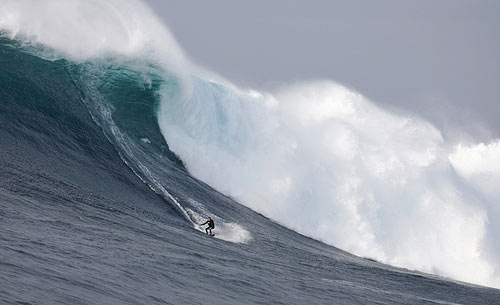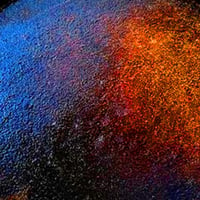kottke.org posts about sports
Preliminary results from a small Swedish study suggest that effects of steroid use stay with you even after stopping.
Rather than returning to their original proportions, the muscles of the steroid users who’d stopped taking the drug looked remarkably similar to those of the subjects who were still using. They also had larger muscle fibers and more growth-inducing “myonuclei” in their muscle cells than the nonsteroid users.
Just got around to reading Ben McGrath’s New Yorker profile of Lenny Dykstra, the former baseball All-Star who has, somewhat improbably, become rich post-baseball as a business owner and day trader.
Dykstra last played in the majors in 1996, at age thirty-three. Improbably, he has since become a successful day trader, and he let me know that he owns both a Maybach (“the best car”) and a Gulfstream (“the best jet”).
But maybe not so improbably…Dykstra has a canny sense for business:
Dykstra chose car washes, he says, because of the automobile-centric culture in California, and because “it was a business that couldn’t be replaced by a computer chip.” He brought his own frustrated consumer experiences to bear in creating the business model, and eliminated many of the usual array of motor-oil choices-startup, high-mileage, various blends-from his inventory. “You get the shit out of the ground,” he said, referring to standard Castrol GTX, “or the shit made in the laboratory that’s the perfect lubricant” (Syntec). “Meaning, it’s either A or B. It’s not about the oil. It’s about the people. They got confused.” He stocked the places with baseball memorabilia and flat-screen TVs, and served free coffee (“the good kind”), so that customers would associate the experience with luxury rather than with cumbersome chores.
One of the characteristics of Dykstra the businessman is his constant use of baseball metaphors and comparisons. Here’s a listing from the article:
The Players Club, in contrast to the television installation, would be “major league,” he explained, and to that end he was assembling an editorial staff of “.300 hitters,” and lining up sponsors to match.
Dykstra’s business card gives an address for the “headquarters” of The Players Club, at 245 Park Avenue, which he describes as “big league-like, top five addresses in the world.”
Next, he took a call from a designer he wanted to hire for the magazine. “You worked for Esquire and In Style,” he said, delivering a pep talk. “That’s called the big leagues. It’s like in baseball. You can’t go above the major leagues. There’s not another league. We’re teeing it up high, dude.”
He quoted from Confucius, Dickens, and Billy Joel, and balanced straight stock picks (“Intel is the N.Y. Yankees of the chipmakers”) with musings about fatherhood and current events, like the war in Iraq, seldom passing up the opportunity to draw extended sports analogies.
“My approach in investing is much the same as my approach to hitting,” he wrote. “I would rather take a walk or single and reach first than shoot for a home run and strike out swinging.”
Dykstra hopes the magazine will help players recognize the importance of marriage and family. He drew three stick figures and named them Tom, Dick, and Harry. Above Tom, he drew a man and a woman-two parents. Dick got a father but no mother, and Harry the reverse. “Do you know the studies and what they’ve proven?” he asked. “You should look that up, dude. Like, bad things. It’s like the one-one count.” The one-one count is another of Dykstra’s baseball metaphors for life, meant to illustrate that some moments, and the choices they bring, are more fateful than others (i.e., the next pitch makes all the difference), or, in this case, that circumstances set in motion during the early stages of development are difficult to overcome later on. If a batter falls behind, one ball and two strikes, he’s in a hole from which, the statistics augur, he will not recover, even if he is Barry Bonds; and if he gets ahead, to two balls and one strike, he wrests control from the pitcher and takes charge of his own destiny. Having two parents puts you in control of life’s count, and enables you to become a .300 hitter.
Here’s an archive of Dykstra’s articles on trading for The Street.
Update: Not so fast, Nails. Seems as though Mr. Dykstra’s business sense was not that good; he recently filed for chapter 11 bankruptcy.
The 46-year-old has no more than $50,000 of assets and between $10 million and $50 million of liabilities, according to a petition filed Tuesday with the U.S. Bankruptcy Court in the Central District of California.
Dykstra’s filing comes in the wake of more than 20 lawsuits he faces tied to his activities as a financial entrepreneur, including The Players Club, a glossy magazine for athletes he had helped launch in 2008.
Sounds like he was a little over-leveraged. (thx, todd)
Bruce Bukiet is back with his annual mathematically modeled prediction of how the upcoming baseball season is going to play out. His results should be taken with a grain of salt; last year he picked the Yankees to win 110 games (they only won 94).
Speaking of the Yankees, Derek Jeter always seems to get a lot of credit for those four World Series victories in five years but a quick look at the OBP stats for those years shows that Bernie Williams was the engine driving that offense. Jeter’s a little overrated maybe?
Steve Nash directed his own Nike commercial. Nash’s original concept for the commercial is clever:
At first, the idea was to shoot on different mediums — camera phone, 8-millimeter, 16-millimeter (the eventual choice), security footage. My idea was the city was watching me. The genesis was a lot of people film me or take a picture of me in the city on cellphones. If it’s such an appetite to see me do normal things, it was an idea to do something people like.
(via truehoop)
A post by Jonah Lehrer about thinking under pressure links deliberate practice with another of my favorite concepts, relaxed concentration. For novice golfers, thinking more about a putt increases their chances of making it. But for experts, thinking about the mechanics of the putt in the same way makes it less likely that they’ll sink it.
Rather than think about the mechanical details of their swing, [expert] golfers should focus on general aspects of their intended movement, or what psychologists call a “holistic cue word”. For instance, instead of contemplating things like the precise position of the wrist or elbow, they should focus on descriptive adjectives like “smooth” or “balanced”. An experimental trial demonstrated that professional golfers who used these “holistic cues” did far better than golfers who consciously tried to control their stroke.
Related: a reader recommended George Leonard’s Mastery as a good read about deliberate practice. (thx, jd)
Update: Another recommendation: Inner Tennis. kottke.org reader Stuart says:
Reading this book a couple of years ago quite honestly transformed my tennis game: I am good at deliberate practice, which had allowed me to become technically very sound, but until then I was completely unable to consciously enter a state of relaxed concentration and execute in a match situation: I was a classic “over thinker”. Gallwey’s book treats relaxed concentration as a skill to be deliberately practiced, and gives an approach to do so. Highly recommended, and fascinating for any (thoughtful) sportsman.
(thx, stuart)
Stephen Dubner wrote a short article on one of my favorite topics of the recent past: deliberate practice.
This means that, your level of natural talent notwithstanding, excellence is accomplished mainly through the tenets of deliberate practice, which are roughly:
1. Focus on technique as opposed to outcome.
2. Set specific goals.
3. Get good, prompt feedback, and use it.
(via clusterflock)
Around All-Star time a couple of weeks ago, Nike released a shoe called the Nike Trash Talk, “the first Nike performance basketball sneaker completely produced from manufacturing waste”. The shoe, worn by Steve Nash in a recent game, looks a bit like Frankenstein’s monster with all the exposed stitching; it’s a beautiful shoe and I want a pair. The problem is that it’s one of those limited edition deals…which means they’re already all sold out and sitting on the shelves of sneaker collectors next to hundreds of other boxes of shoes that will never be worn. I looked on eBay and found two pair but not in my size. What are my chances of getting a pair of these at approximately retail price? I’m not looking for a collectors item…I just want to wear them!
Apparently, the Dribble-Drive Motion offense is all the rage in the high school and college basketball. The DDM is:
a high-scoring scheme featuring four perimeter players and a host of innovations. Unlike Knight’s classic motion offense (which is based on screens) or Pete Carril’s Princeton-style offense (which is based on cuts), Walberg’s attack was founded on dribble penetration. To Calipari, at least, it embodied two wholly unconventional notions. One, there were no screens, the better to create spacing for drives. Two, the post man ran to the weak side of the lane (instead of the ball side), leaving the ball handler an open driving path to the basket.
The Boston Celtics use a variant of DDM as well.
Gelf Magazine enlisted the help of ZEUS, a football game analyzing computer, to see which NFL coaches called the worst plays at critical times during the 2007 season.
On average, suboptimal play-calling decisions cost each team .85 wins over the course of the season.
In particular, the world champion Giants should have won another game had they called the right plays at the right times. ZEUS also analyzed play calling in “hyper-critical” situations (those fourth-down decisions with five or fewer yards needed for the first down) and found that on average, teams made the wrong calls more than 50% of the time. Here’s an interview on the results with the guys behind ZEUS.
Southern hospitality.
At 1 o’clock on a bright October afternoon, I’m standing in a convenience store parking lot five miles east of Martinsville, Va. In the 24 hours before the green flag drops on the Subway 500, I need to find a ride to the speedway and a $75 ticket to the sold-out race. Problem is, all I have on me is $20, a cell phone and a camcorder. And I’m not allowed to use any media connections to get into the race-or so much as mention the letters ESPN (at least not in that order).
(via memeticians)
As we look forward to baseball season starting up, we look back at Stephen Jay Gould remembering the New York teams of his youth.
Thus, I can watch Roger Clemens striking out 15 Mariners in a brilliant one-hitter and place his frame right on top of Don Larsen pitching his perfect game (27 Bums up, 27 Bums down) in 1956. And I can admire the grace of Bernie Williams in center field, while my teenage memories see Mantle’s intensity, and my first impressions of childhood recall DiMaggio’s elegance, in exactly the same spot. I can then place all three images upon the foundation of my father’s stories of DiMaggio as a rookie in the 1936 Series, and my grandfather Papa Joe’s tales of Babe Ruth in the first three New York Series of 1921-1923.
(thx, matt)
In tied football games, the team that wins the coin toss often wins the game. Are there better ways to decide overtime games?
Dueling Kickoffs: To begin overtimes, each team will kick off to each other on consecutive plays. The team that advances the ball furthest will have possession at the point on the field where the ball was advanced. Sudden death is preserved.
Ten quirky baseball rules and oddities, including a list of the 23 ways to get a man on first base. (via subtraction)
Chuck Klosterman writes that the New England Patriots would be better off losing the Super Bowl than compiling a perfect 19-0 season; the final game loss would make them more interesting.
But if they lose — especially if they lose late — the New England Patriots will be the most memorable collection of individuals in the history of pro football. They will prove that nothing in this world is guaranteed, that past returns do not guarantee future results, that failure is what ultimately defines us and that Gisele will probably date a bunch of other dudes in her life, because man is eternally fallible.
Jill Lepore would likely agree with Klosterman. In her recent New Yorker article on Benjamin Franklin (the patron saint of bloggers, BTW), she argues that he failed to follow many of his aphoristic writings and in doing so became more interesting.
He carried with him a little book in which he kept track, day by day, of whether he had lived according to thirteen virtues, including Silence, which he hoped to cultivate “to break a Habit I was getting into of Prattling, Punning and Joking.” What made Franklin great was how nobly he strived for perfection; what makes him almost impossibly interesting is how far short he fell of it.
It’s also worth noting that, per Aristotle and Shakespeare, the hero in a tragedy always has a fatal flaw; it’s what makes him a hero and the story worth listening to.
A recent study shows that when Tiger Woods plays in a golf tournament, the other players perform worse than they do when he doesn’t play.
Analyzing data from round-by-round scores from all PGA tournaments between 2002 and 2006 (over 20,000 player-rounds of golf), Brown finds that competitors fare less well — about an extra stroke per tournament — when Tiger is playing. How can we be sure this is because of Tiger? A few features of the findings lend them plausibility. The effect is stronger for the better, “exempt” players than for the nonexempt players, who have almost no chance of beating Tiger anyway. (Tiger’s presence doesn’t mean much to you if the best you can reasonably expect to finish is about 35th-there’s not much difference between the prize for 35th and 36th place.) The effect is also stronger during Tiger’s hot streaks, when his competitors’ prospects are more clearly dimmed. When Tiger is on, his competitors’ scores were elevated by nearly two strokes when he entered a tournament. And the converse is also true: During Tiger’s well-publicized slump of 2003 and 2004, when he went winless in major events, exempt competitors’ scores were unaffected by Tiger’s presence.
Research papers with a woman as the primary author are more likely to published if the author’s gender is unknown.
Double-blind peer review, in which neither author nor reviewer identity are revealed, is rarely practised in ecology or evolution journals. However, in 2001, double-blind review was introduced by the journal Behavioral Ecology. Following this policy change, there was a significant increase in female first-authored papers, a pattern not observed in a very similar journal that provides reviewers with author information. No negative effects could be identified, suggesting that double-blind review should be considered by other journals.
When watched, squirrels fool would-be nut thieves by pretending to bury nuts.
In the journal Animal Behaviour, biologist Michael Steele at Wilkes University in Pennsylvania examines squirrels’ caching of nuts. While the furry-tailed creatures made a show of digging a hole in the ground and covering it with dirt and leaves when watched, one time out of five they were faking and nothing was buried.
The squirrels’ deception increased after their nut caches were raided.
Art Grand Slam would be the perfect name for a web site showcasing the tennis-related art of Martina Navratilova. And so it is.
Almost 20 years since her last grand slam singles title, Martina Navratilova is back in action on the circuit — only this time she is turning tennis strokes into brush strokes as she helps to create a new form of contemporary art.
In its crudest and, perhaps, most joyful expression, it involves the player hitting paint-covered tennis balls at a canvas, usually marked with court lines and prepared to resemble a playing surface: clay, grass or artificial.
(via quipsologies)
Who wins the Super Bowl of Food: New York City or Boston? Ed Levine says it’s no contest: New York all the way.
What has Boston bestowed upon us, foodwise? Brown bread, baked beans, Boston cream pie, and Parker House rolls. Pretty slim pickins’, don’t you think? How far would you go out of your way for some baked beans or some brown bread? I’d only go a block or two at the most. Now if you expanded the geographic food purview of the Patriots to all of New England, that might be an interesting discussion, because then New England clam chowder, lobster rolls, and fried clams would enter into the fray.
Ed’s a bit hard on Boston here…there’s some excellent food to be found in the city and its surrounds.
In their ongoing quest to be the world’s greatest sports website—heck, the world’s greatest anything website—The Wizznutzz “found” some “never-before-seen personal letters from Pres. Richard Nixon written to Kevin Loughery shortly after the Washington Bullets lost in the 1971 Finals to the Bucks.” There’s a long meditative section on watching crows in a field in winter that is particularly stellar.
Modern big wave surfing requires a knowledge of oceanography and wave dynamics…and quick wits out on the water.
After committing to a wave, the surfer must confront the sheer tonnage of hurtling water and hit a 10-foot-wide slot of the best spot to launch a ride with pinpoint timing, a maneuver that Washburn has described as akin to “trying to place a Dixie cup on the horn of a charging rhino.”
Michael Oher, the subject of Michael Lewis’ book, The Blind Side, is undecided about declaring for the NFL draft after his junior year.
Oher was named to the all-Southeastern Conference first team after the season and is considered one of the top offensive linemen prospects in the country. He has already shown the promise scouts predicted when he was a homeless 16-year-old who didn’t know how to play football.
Meanwhile, the movie adaptation of The Blind Side is proceeding…word on the street is that Brad Pitt, Julia Roberts, and George Clooney are interested in starring.
Update: Oher declared for the draft. (thx, michael)
Update: On second thought, Oher reconsidered and is remaining at Ole Miss for another year. (thx, michael)
For the first time since 1982, an NBA team has won a game protest and the next time the Atlanta Hawks and Miami Heat meet, they’ll replay the final 51.9 seconds of the disputed game before playing the scheduled full game.
Recent Pacific storms have resulted in some epic big wave surfing at Cortes Bank, a seamount located 105 miles off the California coast.

The NY Times has a nice overview:
With a second major storm bearing down, four of the most experienced big-wave surfers in the world launched a boat and two Jet Skis toward Cortes Bank, an underwater mountain range whose tallest peak rises 4,000 feet from the ocean floor to within about four feet of the surface. The perilous spot, about 100 miles off the coast of Southern California, had been surfed only a handful of times in the past decade. With just the right conditions, its shallow waters turn huge ocean swells into giant, perfect breaking waves.
On a big wave site set up by Billabong, one of the riders said that 100-foot waves will be ridden out there:
Cortes Bank veteran Mike Parsons returned from the voyage absolutely certain that larger sea monsters are awaiting around the spooky open-ocean shoal. “It’s getting closer and closer now…I guarantee you there will be a 100-foot-wave ridden out there,” said Parsons. “For sure. There were several big peaks that jumped up at the top of the reef outside of us that could not have been too far off that size. If you put yourself in the right place at the right time, it will happen. It’s only a matter of time now.”
For photos and a nice audio feature with the crew that took the trip out there, head on over to Surfline.
Todd Gallagher explores the myth of grabbing a dollar bill off the top of a basketball backboard and tries to find someone who can do it.
The legend of touching the top of the backboard has gone on for years, and it has been excitedly attributed to so many different players that it’s commonly assumed any number of guys in the NBA can do it. But in a sport where any individual achievement is promoted ad nauseam, we’ve never seen any proof of it actually being done.
Check out these videos of his leading candidate, James White: White doing a between-the-legs dunk from the free throw line and his dunks from the 2006 NCAA dunk contest.
Burton is offering a $5000 prize for the best snowboarding video taken at one of the three remaining US ski areas (Alta, Taos, Deer Valley, Mad River Glen) that don’t allow snowboarding. The intro video is the perfect explanation for why these four areas don’t allow snowboards.
The NFL has caved and is going to simulcast the Patriots/Giants game on NBC and CBS instead of just showing it on NFL Network, a channel available to fewer than 40% of US households.
Nurture is really kicking ass these days….first the IQ thing and now this.
The offspring of expensive stallions owe their success more to how they are reared, trained and ridden than good genes, a study has found. Only 10% of a horse’s lifetime winnings can be attributed to their bloodline, research in Biology Letters shows.
That suggests, a la Moneyball, that buying horses with so-so lineages and training them really well could make for a better return on investment.
Newer posts
Older posts






Stay Connected